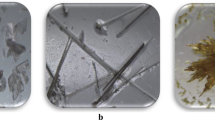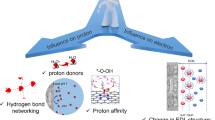Abstract
To determine the detailed mechanism of 2-chlorophenol (2-CP) oxidation in supercritical water, both the experiments and theoretical calculations were conducted in this paper. A set of experiments was performed to oxidize 2-CP in supercritical water under temperatures of 380–420 °C, pressure of 25 MPa, residence times of 0–60 s, and H2O2 as oxidant. By determining the molar yields of products, the primary single-ring products were identified as chlorohydroquinone, 2,4-dichlorophenol (2,4-DCP), 2,6-DCP, and 4-CP. The trends for the molar yields of the four products were analyzed at various temperatures and residence times. And built upon the trends, the possible reaction pathways were conjectured. Subsequently, the reaction mechanism was further verified by theoretical calculations, in which density functional theory was adopted as the computational method. The calculated results have well illustrated the experimental results and ascertained the reaction paths we proposed.









Similar content being viewed by others
References
P.M. Armenante, D. Kafkewitz, G.A. Lewandowski, C.J. Jou, Anaerobic–aerobic treatment of halogenated phenolic compounds. Water Res. 33, 681–692 (1999)
U.G. Ahlborg, T.M. Thunberg, H.C. Spencer, Chlorinated phenols: occurrence, toxicity, metabolism, and environmental impact. CRC Crit. Rev. Toxicol. 7, 1–35 (1980)
L. Keith, Compilation of Sampling Analysis Methods (US Environmental Protection Agency, Boca Raton, 1991), pp. 389–486
M.A. Callahan et al., Water-Related Environmental Fate of 129 Priority Pollutants (Office of Water Planning and Standards, Office of Water and Waste Management, U.S. Environmental Protection Agency, Washington, DC, 1979)
A.O. Olaniran, E.O. Igbinosa, Chlorophenols and other related derivatives of environmental concern: properties, distribution and microbial degradation processes. Chemosphere 83, 1297–1306 (2011)
D. Sun, H. Zhang, Electrochemical determination of 2-chlorophenol using an acetylene black film modified glassy carbon electrode. Water Res. 40, 3069–3074 (2006)
J.D. Rodgers, W. Jedral, N.J. Bunce, Electrochemical oxidation of chlorinated phenols. Environ. Sci. Technol. 33, 1453–1457 (1999)
A.M. Polcaro, S. Palmas, Electrochemical oxidation of chlorophenols. Ind. Eng. Chem. Res. 36, 1791–1798 (1997)
J. Yang, J. Dai, C. Chen, J. Zhao, Effects of hydroxyl radicals and oxygen species on the 4-chlorophenol degradation by photoelectrocatalytic reactions with TiO2-film electrodes. J. Photochem. Photobiol. A 208, 66–77 (2009)
N. Rao, A. Dubey, S. Mohanty, P. Khare, R. Jain, S. Kaul, Photocatalytic degradation of 2-chlorophenol: a study of kinetics, intermediates and biodegradability. J. Hazard. Mater. 101, 301–314 (2003)
M. Czaplicka, Photo-degradation of chlorophenols in the aqueous solution. J. Hazard. Mater. 134, 45–59 (2006)
Y. Cheng, H. Sun, W. Jin, N. Xu, Photocatalytic degradation of 4-chlorophenol with combustion synthesized TiO2 under visible light irradiation. Chem. Eng. J. 128, 127–133 (2007)
M. Munoz, Z.M. de Pedro, J.A. Casas, J.J. Rodriguez, Assessment of the generation of chlorinated byproducts upon Fenton-like oxidation of chlorophenols at different conditions. J. Hazard. Mater. 190, 993–1000 (2011)
R. Li, P.E. Savage, D. Szmukler, 2-Chlorophenol oxidation in supercritical water: global kinetics and reaction products. AlChE J. 39, 178–187 (1993)
G. Lee, T. Nunoura, Y. Matsumura, K. Yamamoto, Effects of a sodium hydroxide addition on the decomposition of 2-chlorophenol in supercritical water. Ind. Eng. Chem. Res. 41, 5427–5431 (2002)
Z. Sun, F. Takahashi, Y. Odaka, K. Fukushi, Y. Oshima, K. Yamamoto, Effects of potassium alkalis and sodium alkalis on the dechlorination of o-chlorophenol in supercritical water. Chemosphere 66, 151–157 (2007)
H.C. Lee, J.H. In, J.H. Kim, K.Y. Hwang, C.H. Lee, Kinetic analysis for decomposition of 2,4-dichlorophenol by supercritical water oxidation. Korean J. Chem. Eng. 22, 882–888 (2005)
P.E. Savage, S. Gopalan, T.I. Mizan, C.J. Martino, E.E. Brock, Reactions at supercritical conditions: applications and fundamentals. AlChE J. 41, 1723–1778 (1995)
W.R. Killilea, K. Swallow, G.T. Hong, The fate of nitrogen in supercritical-water oxidation. J. Supercrit. Fluids 5, 72–78 (1992)
T.J. Park, J.S. Lim, Y.W. Lee, S.H. Kim, Catalytic supercritical water oxidation of wastewater from terephthalic acid manufacturing process. J. Supercrit. Fluids 26, 201–213 (2003)
H. Pińkowska, P. Wolak, A. Złocińska, Hydrothermal decomposition of alkali lignin in sub- and supercritical water. Chem. Eng. J. 187, 410–414 (2012)
M. Goto, T. Nada, A. Ogata, A. Kodama, T. Hirose, Supercritical water oxidation for the destruction of municipal excess sludge and alcohol distillery wastewater of molasses. J. Supercrit. Fluids 13, 277–282 (1998)
P.E. Savage, Organic chemical reactions in supercritical water. Chem. Rev. 99, 603–622 (1999)
T.D. Thornton, P.E. Savage, Phenol oxidation pathways in supercritical water. Ind. Eng. Chem. Res. 31, 2451–2456 (1992)
V. Marulanda, G. Bolaños, Supercritical water oxidation of a heavily PCB-contaminated mineral transformer oil: laboratory-scale data and economic assessment. J. Supercrit. Fluids 54, 258–265 (2010)
G. Anitescu, L.L. Tavlarides, Oxidation of Aroclor 1248 in supercritical water: a global kinetic study. Ind. Eng. Chem. Res. 39, 583–591 (2000)
Q. Guan, C. Wei, X.-S. Chai, Pathways and kinetics of partial oxidation of phenol in supercritical water. Chem. Eng. J. 175, 201–206 (2011)
X. Quan, H. Shi, J. Wang, Y. Qian, Biodegradation of 2,4-dichlorophenol in sequencing batch reactors augmented with immobilized mixed culture. Chemosphere 50, 1069–1074 (2003)
W.Z. Tang, C. Huang, Photocatalyzed oxidation pathways of 2,4-dichlorophenol by CdS in basic and acidic aqueous solutions. Water Res. 29, 745–756 (1995)
P. Boule, C. Guyon, J. Lemaire, Photochemistry and environment IV—photochemical behaviour of monochlorophenols in dilute aqueous solution. Chemosphere 11, 1179–1188 (1982)
N. Akai, S. Kudoh, M. Takayanagi, M. Nakata, Photoreaction mechanisms of 2-chlorophenol and its multiple chloro-substituted derivatives studied by low-temperature matrix-isolation infrared spectroscopy and density-functional-theory calculations. J. Photochem. Photobiol. A 146, 49–57 (2001)
C. Wei, D. Li, H. Shi, Q. Guan, Y. Hu, Dechlorination kinetics and mechanism of p-chlorophenol in supercritical water. Zhongguo Keji Lunwen Zaixian/Sci. Pap. Online 5, 441–447 (2010)
G. Lee, T. Nunoura, Y. Matsumura, K. Yamamoto, Comparison of the effects of the addition of NaOH on the decomposition of 2-chlorophenol and phenol in supercritical water and under supercritical water oxidation conditions. J. Supercrit. Fluids 24, 239–250 (2002)
M. Frisch, G. Trucks, H. Schlegel, G. Scuseria, M. Robb, J. Cheeseman, J. Montgomery Jr., T. Vreven, K. Kudin, J. Burant, Gaussian 03, Revision D. 01 (Gaussian, Wallingford, 2004)
Y. Zhao, D. Truhlar, Hybrid meta density functional theory methods for thermochemistry, thermochemical kinetics, and noncovalent interactions: the MPW1B95 and MPWB1K models and comparative assessments for hydrogen bonding and van der Waals interactions. J. Phys. Chem. A 108, 6908–6918 (2004)
K. Fukui, The path of chemical reactions—the IRC approach. Acc. Chem. Res. 14, 363–368 (1981)
S.F. Rice, T.B. Hunter, Å.C. Rydén, R.G. Hanush, Raman spectroscopic measurement of oxidation in supercritical water. 1. Conversion of methanol to formaldehyde. Ind. Eng. Chem. Res. 35, 2161–2171 (1996)
E. Croiset, S.F. Rice, Direct observation of H2O2 during alcohol oxidation by O2 in supercritical water. Ind. Eng. Chem. Res. 37, 1755–1760 (1998)
E. Croiset, S.F. Rice, R.G. Hanush, Hydrogen peroxide decomposition in supercritical water. AlChE J. 43, 2343–2352 (1997)
K.S. Lin, H.P. Wang, Supercritical water oxidation of 2-chlorophenol catalyzed by Cu2+ cations and copper oxide clusters. Environ. Sci. Technol. 34, 4849–4854 (2000)
D. Shchukin, S. Poznyak, A. Kulak, P. Pichat, TiO2–In2O3 photocatalysts: preparation, characterisations and activity for 2-chlorophenol degradation in water. J. Photochem. Photobiol. A 162, 423–430 (2004)
M. Bertelli, E. Selli, Reaction paths and efficiency of photocatalysis on TiO2 and of H2O2 photolysis in the degradation of 2-chlorophenol. J. Hazard. Mater. 138, 46–52 (2006)
Z. Han, D. Zhang, Y. Sun, C. Liu, Reexamination of the reaction of 4-chlorophenol with hydroxyl radical. Chem. Phys. Lett. 474, 62–66 (2009)
Acknowledgments
This research is supported by the National High Technology Research and Development Program of China (863 Program, the Project No. 2007AA05Z235). We acknowledge the research foundation of Shandong Environmental Protection Bureau for support. We also thank the independent innovation project for the University Institutes of Jinan Technology Bureau (No. 201 102 046).
Author information
Authors and Affiliations
Corresponding author
Rights and permissions
About this article
Cite this article
Zhang, J., Ma, C., Sun, Y. et al. Hydroxyl radical reactions with 2-chlorophenol as a model for oxidation in supercritical water. Res Chem Intermed 40, 973–990 (2014). https://doi.org/10.1007/s11164-012-1015-x
Received:
Accepted:
Published:
Issue Date:
DOI: https://doi.org/10.1007/s11164-012-1015-x




